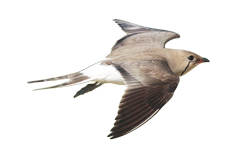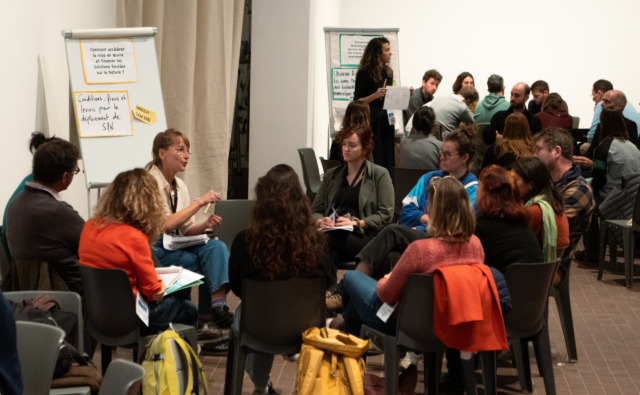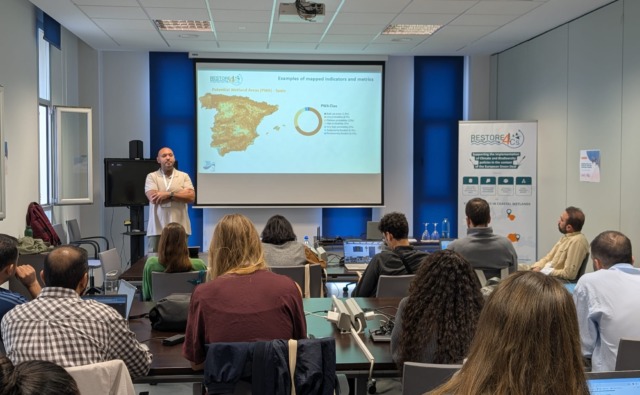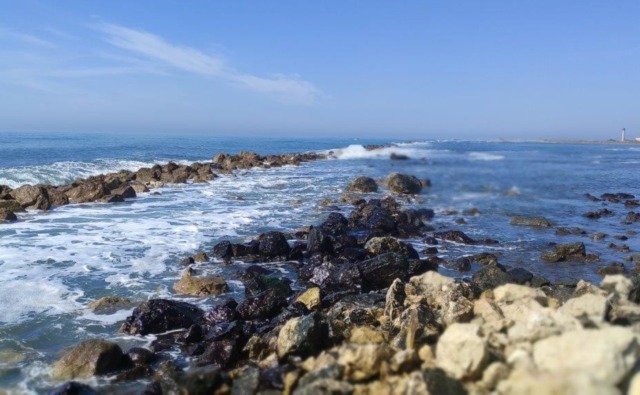Ecological restoration
Objectives
The aims of the project are:
- to test restoration methods and assess their pertinence in function of the context;
- to apply these methods to sites;
- to promote management systems that are favourable to restoration.
Main research themes
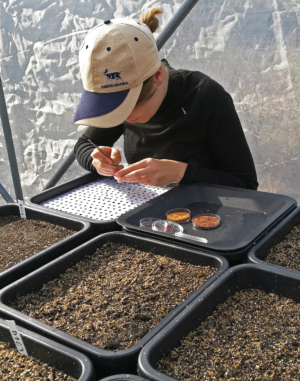 Grazing as a major tool for restoration and management
Grazing as a major tool for restoration and management
Domesticated herbivores are used for their capacity to favour diversity at various spatial scales. The experiments are being carried out on the Estate, in the Camargue, and at other sites in the Mediterranean region, particularly the Donzère-Mondragon hunting reserve (Cannelle Moinardeau’s thesis, in collaboration with the Mediterranean Institute of Biology and Ecology – IMBE). This role of “ecosystem engineers” is not limited to mammals alone, and the impact of ants is also being tested in dry grasslands, where they are expected to favour the development of key species with low colonisation dynamics (Tania De Almeida’s thesis, in collaboration with the IMBE).
Introduction of species
When wetlands are rehabilitated, many plants colonise them naturally. However, the slowness of this colonisation can limit the arrival of target wildlife and/or make the habitat vulnerable to undesirable species, in which case the transfer of propagules is required. The rehabilitation of the Le Cassaïre site (70 ha) in the Camargue (village of Mas Thibert, municipality of Arles) gives us the opportunity to test the relevance of techniques of species introduction to recreate a high conservation- and hunting-value wetland from abandoned agricultural land.
Controlling undesirable species
The sowing of commercially available seeds is commonly used to limit the permeability of vulnerable habitats with regard to undesirable species. The benefits of selecting a particular density, diversity, or certain characteristics of the species sowed are being investigated in another thesis (Manon Hess, in collaboration with the IMBE). The possibility of treating infested soils directly in the field to destroy any chance of the invasive species reproducing is also being tested, in the framework of the development of an industrial process (PARIS project).
Setting up hydrological conditions and ad hoc water management systems
This theme concerns all the sites where we are involved, in particular:
- the site of the Camargue Saltworks Lagoons and Marshes, where nearly 7000 hectares of costal ecosystems are to be rehabilitated by reconnecting their hydrobiological systems with the sea and upstream lagoons, together with the setting up of new water management systems;
- the population of the loosestrife Lythrum thesioides in a set of temporary ponds located close to the new Nîmes bypass high-speed train line, for which the right conditions for its restoration and conservation need to be defined and implemented (Antoine Gazaix’s thesis, in collaboration with CEFE-CNRS).
Team
- Project leader: François Mesléard
- Staff involved: Olivier Boutron, Tania De Almeida, Lisa Ernoul, Hugo Fontes, Antoine Gazaix, Patrick Grillas, Samuel Hilaire, Manon Hess, Philippe Lambret, Gaëtan Lefebvre, Cannelle Moinardeau, Brigitte Poulin, Marc Thibault, Loïc Willm
- Date of project: Since 2010
Partners
Scientific and technical partners
- Amis des Marais du Vigueirat
- CIRAD-Montpellier
- Conservatoire du littoral
- EDF
- GECO – Ingéniérie
- NGE – Guintoli
- Sairem
- INRA Montpellier
- Mediterranean Institute of Biodiversity and Ecology (IMBE) Avignon & Marseille
- Ministère de la transition écologique et solidaire (French ecological transition and solidarity ministry)
- Camargue Regional Natural Park
- National Nature Protection Society
- Aarhus University
- Avignon University
- Université catholique de Louvain
- Rennes University
Financial partners
- Rhone-Mediterranean-Corsica Water Agency
- Banque publique d’investissement
- Compagnie Nationale du Rhône
- Bouches-du-Rhône General Council
- Ain Departmental Council
- European Union (LIFE programme)
- NGE – Guintoli
- National Hunting and Wildlife Office (ONCFS)
- Oc’via
- Grand Port Maritime de Marseille
- Occitanie Region
- Provence-Alpes-Côte d’Azur Region
- SNCF Réseau
- WWF-France
Main publications
- De Wilde M., Buisson E., Yavercovski N., Willm L., Bieder L., Mesléard F. 2017. Using microwave soil heating to inhibit invasive species seed germination. Invasive Plant Science and Management. DOI 10.1017/inp.2017.29
- Mesléard F., Yavercovski N., Lefebvre G., Willm L., Bonis A. 2017 High stocking density controls Phillyrea angustifolia in mediterranean grasslands. Environmental Managment, 59 (3): 455– 463. doi: doi: 10.1007/s00267-016-0808-x
- Loranger J., Violle C., Shipley B., Lavorel S., Bonis A., Cruz P., Louault F., Loucougaray G.,Mesléard F., Yavercovski N., Garnier E 2016. Recasting the dynamic equilibrium model through a functional lens: the interplay of trait-based community assembly and climate. Journal of Ecology. 104, 781–791 doi: https://doi.org/10.5061/dryad.k2k08/1
- Mesléard F., Yavercovski N & Dutoit T. 2016. Photoperiod buffer responses to salt and temperature during germination of to coastal salt-marsh colonizers Juncus acutus and Juncus maritimus. Plant Biosystems, 150: 1156-1164. doi: http://dx.doi.org/10.1080/11263504.2015.1007898
- Moinardeau C., Mesléard F. & Dutoit 2016 Using different grazing practices for increasing plant biodiversity in the dykes and embankments along the Rhone river (Southern France). Environmental Management 58(6): 985-997. doi: https://doi.org/10.1007/s0026
- Masson S., Mesléard F. & Dutoit T. 2015 Impacts of water stress removal and disturbance regimes on Mediterranean dry grasslands diversity and succession”, Plant Ecology, 216 :1351-1369. doi: https://doi.org/10.1007/s11258-015-0513-5
- Mason S., Mesléard F. & Dutoit F. 2015. Using Shrub Clearing, Draining, and Herbivory to Control Bramble Invasion in Mediterranean Dry Grasslands. Environmental Management, 56 (4) 933-945. doi: https://doi.org/10.1007/s00267-015-0541-x
- Merlin, A. Bonis A., Damgaard, F. Mesléard, F 2015. Competition Is a Strong Driving Factor in Wetlands, Peaking during Drying Out Periods. PLoSONE, 10(6), . doi : https://doi.org/10.1371/journal.pone.0130152
- Gardarin G, Garnier ,E, Carrère P., Cruz P. Andueza D., Bonis A., Colace M-P. Dumont B., Duru M. Farruggia A., Gaucherand S., Grikuls K., Kerneis E., Lavorel S., Louault F., Loucougaray G., Mesléard F., Yavercovski Y& Kazakou E. 2014 Plant trait-digestibility relationships across management and climate gradients in permanent grasslands. Journal of applied Ecology, 51: 1207-1217. doi: https://doi.org/10.1111/1365-2664.12293
- Masson S., Mesléard F. & Dutoit T. 2014. Impacts de différents régimes de perturbations et/ou d’accès aux ressources trophiques pour contrôler une espèce proliférante dans un écosystème pseudo-steppique: le cas de Rubus ulmifolius Schott. dans la plaine de la Crau (Bouches-du-Rhône, France), Botany letters , 161: 261-276. doi: http://dx.doi.org/10.1080/12538078.2014.911113
- Muller I., Buisson E., Mouronval J.B. & Mesléard F. 2014. Temporary pool restoration after rice cultivation: is soil transfer required for aquatic plant colonization? Knowledge and Management in Aquatic ecosystems,411 (03) 03 DOI: 10.1051/kmae/2013067
- Muller, I., Mesléard, F. & Buisson, E. 2014. Effect of topsoil removal and plant material transfer on vegetation development in created Mediterranean meso-xeric grasslands. Applied Vegetation Science, 17: 246-261 doi: 10.1111/avsc.12059
- Jaunatre R., Buisson E., Muller I; Morlon H. Mesléard F & Dutoit 2013. New synthetic indicators to assess community resilience and restoration success. Ecological Indicators, 29: 468-477 doi: http://dx.doi.org/10.1016/j.ecolind.2013.01.023
- Baumberger T., Mesléard F., Croze T.& Affre L. 2012. Effects of submersion on survival, growth, and biomass allocation according to development stages of the rare halophyte Limonium girardianum Aquatic Botany, 102:65-70 doi: http://dx.doi.org/10.1016/j.aquabot.2012.05.003
- Dumont B., Rossignol N., Loucougaray G., Carrère P., Chadoeuf J., Fleurance G., Bonis A., Farruggia A., Gaucherand S., Ginane C., Louault F.; Marion B., Mesléard F., Yavercovski Y. 2012. When does grazing generate stable vegetation patterns in temperate pastures? Agriculture Ecosytems & Environment,153:50-56 doi: https://doi.org/10.1016/j.agge.2012.03.003
- Baumberger T, Croze T., Affre L. & Mesléard F. 2012 Co-occurring species indicate rare species’ habitats: the case of Limonium girardianum Plant Ecology Evolution,145: 31-37 doi: : http://dx.doi.org/10.5091/plecevo.2012.685
- Baumberger T., Affre L., Croze T. & Mesléard F. 2012. Habitat requirements and population structure of the rare endangered Limonium girardianum in industrialized salt marshes Flora, 207: 283-293 doi: http://.doi.org/10.1016/j.flora.2011.11.008
- Draagmar Ch., Merlin A., Mesléard F., Bonis A. 2011. The demography of space occupancy: measuring plant colonisation and survival probabilities using repeated pin-point measurements Methods in Ecology and Evolution, 2: 110-115. Doi: https://doi.org/10.1371/journal.pone.0130152-
- Mesléard F., Mauchamp A. Pineau O. & Dutoit T. 2011. Rabbit is more effective than cattle to limit shrub colonization in Mediterranean xero-halophitic meadows. Ecoscience 18 (1): 37-41 doi: https://doi.org/10.2980/18-1-3383
